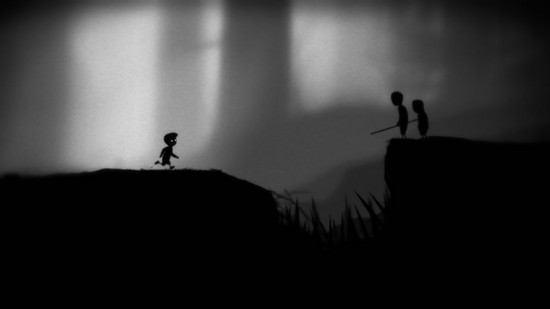I haven’t been away from the game long enough to write a formal deconstruction, but I’ve been talking to a lot of friends about Playdead’s Limbo recently. My opinion differs from the majority (not to say I’m on my own), and I think writing it in the blog is the best way to articulate the angle I’m coming from. In doing so, I hope I’ll be able to get some feedback on why the things that bothered me made the game better for everyone else.
Art Style
The first thing everyone talks about when they see Limbo is the unique minimalist art style. It’s looks absolutely beautiful in motion, and it creates an incredible mood for the game’s world. It evokes all sorts of emotions without the use of language, and it undeniably leaves an impression with the player.
Unfortunately, I found a huge drawback to this art style in the context of Limbo‘s gameplay. It’s not always clear what the player can and can’t interact with in each area, and the VFX often work against it. The majority of the times I got stuck in the game were because I didn’t know what I was supposed to be interacting with (i.e. pushing buttons on signs that change the direction of gravity). I’m all for a cool look, but it’s a design failure when it interferes with the player’s ability to understand their environments. It’s not “clever†or “innovative†to confuse the player about what they can and can’t interact with in the game world, and a few too many puzzles fell into that category for my taste.
Death
Like Another World before it, Limbo has an obscene number of graphic death scenes. It’s no secret that, no matter how attached to their characters, players love seeing them get mangled in creative and unexpected ways – take a look at Dead Space or Resident Evil, for example. There are “all the ways to die†videos on YouTube with millions of hits, and artists clearly put a lot of effort into making sure players are satisfied.
The difference between deaths in Dead Space and Limbo is that the player doesn’t always have control in Limbo. In fact, death is treated not as a punishment for failure but as a way of showing the player the solution to a scripted event puzzle. One section in particular highlights this, where the player approaches a switch surrounded by two small crevices on either side. Stepping on the switch causes a piston to come down and smash the player into the ground. A few steps further down the hallway lies an identical looking switch, but stepping on this switch is actually the only way to prevent the piston from falling. There are no visual cues to solving this puzzle before you get to it – the player must learn entirely from trial and error.
It’s harmless enough because the game respawns the player right in front of the switch hallway, but why is it necessary? Are players supposed to think the developer is clever for misleading them? Is it just a general “screw you†to the audience? Here’s a game that is advertised for its artistic value and innovation, and puzzles like this are simply time wasters that artificially extend an already short gameplay experience.
Death animations are only entertaining to a point. Limbo’s shining moments are its clever puzzles, and these death scenes are the complete opposite. Roughly 10% of the events in the game are nearly impossible to avoid on the first attempt, 60% are trial and error, and the remaining 30% are actually clever puzzles that award the player with a sense of accomplishment.
Takeaways
Much like the world of the game itself, Limbo’s moments of brilliance are shrouded in darkness. This is a game I really wanted to like – I bought it before trying the demo and talked about it with friends before its release – but I found it to be a huge disappointment. It’s not a bad game by any stretch of the imagination, but it’s not worth fifteen dollars and I’m baffled as to how it’s maintained over a 90 on Metacritic. It’s easily trumped by Xbox Live companions ’Splosion Man and Braid. Maybe today’s gamers really do appreciate those crazy death animations more than actual game design.

This was a shit review. Really. =)
I try.